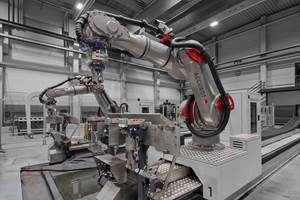DLR researchers develop new repair concept for FRPs
The process uses a laser, induction and a vacuum on damaged areas.
Researchers at the German Aerospace Center (DLR, Stuttgart, Germany) have developed a new repair concept for fiber-reinforced polymers (FRPs) with the aim to avoid the premature disposal of FRP components and to minimize waste during production.
Since the production of FRP components is complex and costly, the repair processes is generally time-intensive and expensive. Large structures – such as those in an aircraft fuselage – are designed for a service life of up to 30 years. “In the event of damage, they usually have to be removed for repair or completely replaced," said Project Leader Markus Kaden from DLR.
With metal structures, the damaged area is cut out and new metal riveted in. Components made of fiber-reinforced polymers require a more complex repair process. "As the fibers are load-bearing and are responsible for the cohesion and resilience of the structure, we cannot simply drill and rivet here; that would only damage the fibers even more," says Kaden. Instead, the DLR scientists remove the damaged layers of the material and replace them with a patch similar to a sticking plaster. The patch is made of the same material, has the same fiber alignment and is bonded to the surrounding structure using the effects of heat and pressure.
The repair process used by DLR here has two special features. First, the damaged material is removed using a laser. This process does not require any cooling; there are no clamping or pressure forces on the structure and the tool wear is very limited.
Second, the researchers only heat the area of the patch and the damaged area of the structure. They do so using a metal sheet heated by induction that is the same size as the patch and is pressed onto the patch by creating a vacuum. The patch is then bonded with the surrounding structure under pressure and at a high temperature, Kaden said.
The researchers believe the new repair method offers more flexibility than previous technologies. By using ovens or autoclaves, the entire component is heated. Heating blankets, infrared lights or heated air systems offer the possibility of heating only parts of the structure, but are not specifically targeted to the specific area to be repaired. At the same time, DLR uses an additional insulation layer to achieve temperatures of over 300 degrees Celsius so that even thermoplastics can be repaired.
Working with the DLR technology marketing team, the researchers in Stuttgart have developed a mobile repair station that can be used to demonstrate the process. It includes all the systems required for repairing FRP structures. In addition to the equipment for inductive heating of the metal sheet, it has a vacuum pump for generating the required pressure on the patch. The individual processes can be controlled via a netbook using temperature sensors.
Currently, 'bonding' is not yet approved in the aviation sector for repairing load-bearing structural components made of high-performance composites. However, Kaden is optimistic. "There are currently many new developments in this area. Several companies have already shown interest in our repair concept and in developing it further for industrial use," he said.
Related Content
Automated robotic NDT enhances capabilities for composites
Kineco Kaman Composites India uses a bespoke Fill Accubot ultrasonic testing system to boost inspection efficiency and productivity.
Read MoreOtto Aviation launches Phantom 3500 business jet with all-composite airframe from Leonardo
Promising 60% less fuel burn and 90% less emissions using SAF, the super-laminar flow design with windowless fuselage will be built using RTM in Florida facility with certification slated for 2030.
Read MoreInfinite Composites: Type V tanks for space, hydrogen, automotive and more
After a decade of proving its linerless, weight-saving composite tanks with NASA and more than 30 aerospace companies, this CryoSphere pioneer is scaling for growth in commercial space and sustainable transportation on Earth.
Read MoreWelding is not bonding
Discussion of the issues in our understanding of thermoplastic composite welded structures and certification of the latest materials and welding technologies for future airframes.
Read MoreRead Next
Ultrasonic welding for in-space manufacturing of CFRTP
Agile Ultrasonics and NASA trial robotic-compatible carbon fiber-reinforced thermoplastic ultrasonic welding technology for space structures.
Read MoreScaling up, optimizing the flax fiber composite camper
Greenlander’s Sherpa RV cab, which is largely constructed from flax fiber/bio-epoxy sandwich panels, nears commercial production readiness and next-generation scale-up.
Read MoreCeramic matrix composites: Faster, cheaper, higher temperature
New players proliferate, increasing CMC materials and manufacturing capacity, novel processes and automation to meet demand for higher part volumes and performance.
Read More












